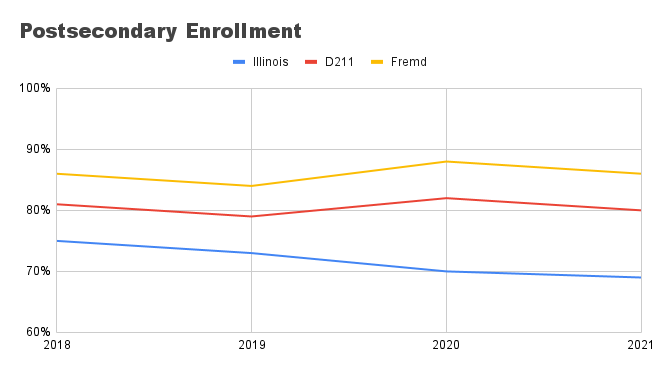Fremd outperforms Illinois schools despite pandemic, 2021 Illinois Report Card reports
November 23, 2021
The annual Illinois Report Card Public Data Set was recently updated on Nov. 2, 2021 by the Illinois State Board of Education (ISBE), releasing statistics regarding trends within statewide education. A report that began in 2007, the ISBE has been analyzing and recording issues such as race enrollment, average class size, minutes devoted to core subjects, dropout rate, standardized test average, graduation rate, and much more every year for 15 years. Based on this data, the ISBE has been working towards adjusting and improving Illinois educational systems.
The Viking Logue has done a comprehensive analysis between the 1) state-wide Illinois report card, 2) District 211 report card, and 3) the local William Fremd High School report card to compare the educational effects of the COVID-19 pandemic in all three spectrums. All data was provided by the ISBE.
9th grade students on track
The trend in the number of “9th grade students on track” was one visible difference representing the overall trend of how Illinois, District 211, and Fremd educational conditions were affected by the pandemic. The criteria for being on track include having at least 5 full-year course credits and no more than one semester F in a core subject.
In Illinois, the percentage rose 2% from 2019 to 2020, but then dropped a drastic 7% from 2020 to 2021. District 211 was a more subtle decline of 3%, returning back to its percentage from 2018. On the other hand, Fremd only dropped 1%, holding a fairly consistent percentage. It appears that Fremd had nearly no negative impact from the pandemic, at least in regards to the number of freshmen students still on track.


Postsecondary Enrollment
Another category is “postsecondary enrollment,” which refers to the percentage of students who graduated from high school and are able to get into a two or four year U.S. college within 12 months.
For the state, there was a constant decrease from a range of 1-3% from 2019-2021. Interestingly, District 211 and Fremd have very similar trends, as both spectrums decreased by 2% from 2018-2019, increased by 3-4% from 2019-2020, and decreased 2% from 2020-2021. Again, the data seems to be potential evidence for the detrimental effect COVID-19 has on the state, and a lesser impact in the more local regions.


ISBE addresses this concern for the state’s educational situation by posing future solutions and efforts into aiding students that are not currently on track to succeeding in their high school career.
“ISBE encourages schools to watch this cohort closely and direct federal pandemic relief funds to research-based interventions for current 10th graders not on track for graduation. ISBE plans to launch a high-impact tutoring initiative in early 2022, supported by $37.5 million in federal pandemic relief funding, to provide direct interventions for students across the education continuum.”


